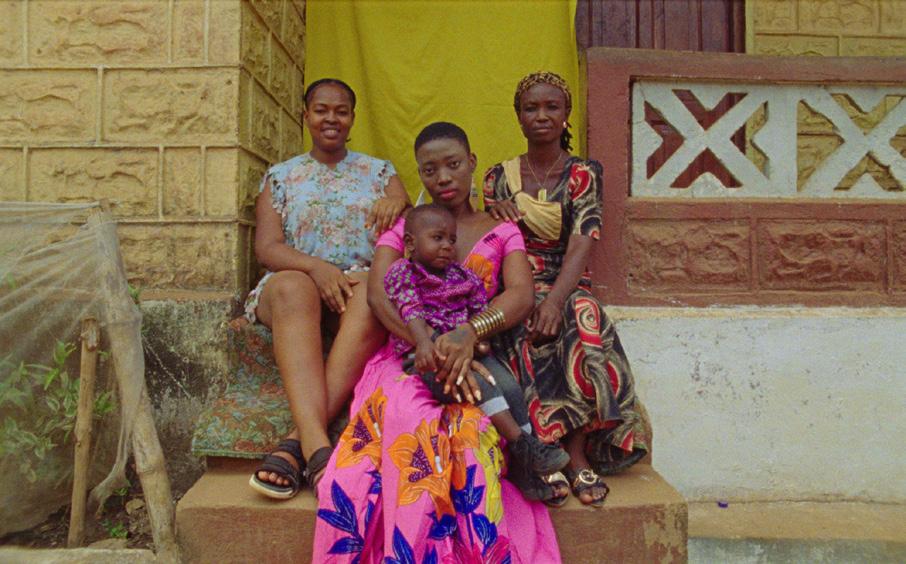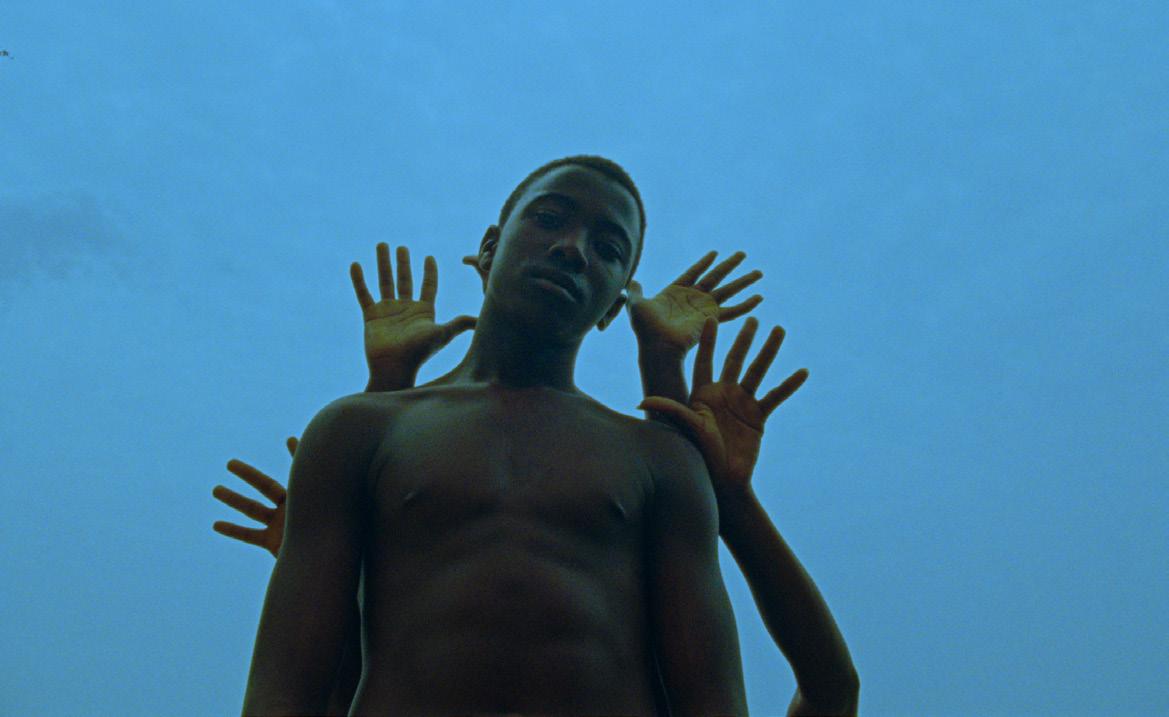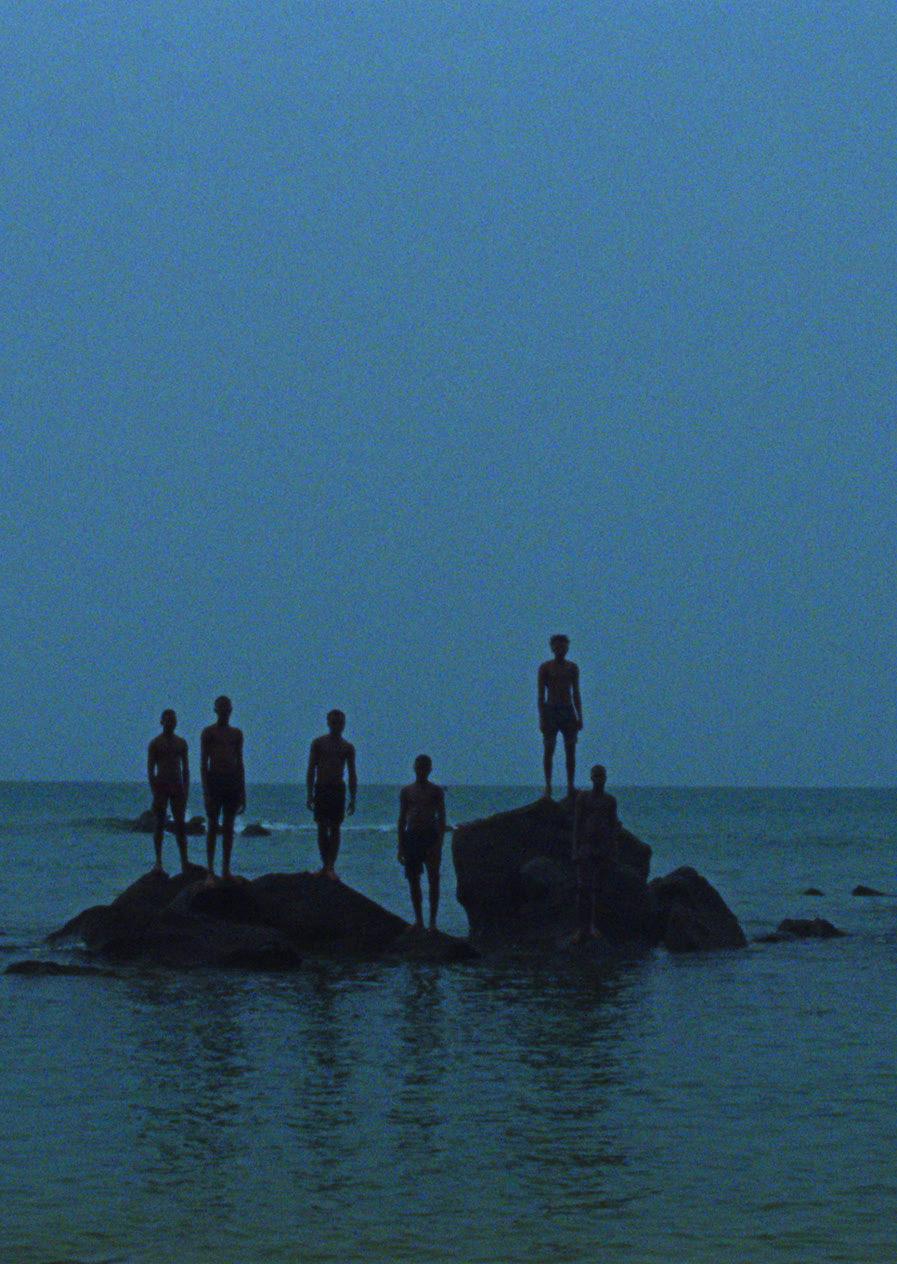
10 minute read
'In Praise of Still Boys' by Julian Knox
from SAASUM REVIEW 2021
by saasumreview
EMEFA DZIVENU
In ‘In Praise of Still Boys’ you combine poetry, performance, and film to discover and depict boyhood in Sierra Leone. Can you discuss the background for this work and what your starting points were?
Advertisement
Almost all my artwork begins with poetry. The piece began with a series of poems that were based on reflections that I had on Sierra Leone as well as my own personal history. The ambition for the work was for it to exist as a collection
of poems that can be read with both an audio and or a visual component. The film was the last element that I wanted to execute. I wanted to respect each form, which is why each aspect of the film can stand on its own.

The standalone film does serve as a visual poem. Why did you decide to use both visual and written elements to tell the story?
I’m a very visual person. I make sense of the world through imagery. Even my poems are very descriptive, and the words sketch out the pictures and ideas that I want to convey.
I also feel that many art forms have incorporated technological aspects during our digital age, yet as poets we remain stuck to the page. I’m very interested in moving poetry from print into the world of digital technology in a way that speaks to my work and utilising various capabilities to expand my narratives.
Relating to my film’s specific backdrop, most people don’t have references for a lot of the settings depicted in black art and literature. I can describe the beautiful beaches and people of Sierra Leone, but visuals help in terms of taking you into a space and a world that most people just don’t understand.
You moved to Gambia when you were nine after the Sierra Leonean Civil war forced your family to leave, later making your way to the UK. This type of dislocation has and continues to be a relevant theme for the diaspora. How do you think loss, memory, and cultural and spatial displacement inform this film, your other work as an artist, and the diasporic imagination as a whole?
This type of dislocation in the black experience hasn’t just influenced my work; it’s influenced me. Being Creole or Krio in Sierra Leone is the epitome of displacement, with our identity as Africans who traveled to the Americas and then chose to or were told to come back home to Sierra Leone. But was it still home? This point of departure and return is at the core of being Krio. Language and culture emerged from the loss of identity and search for identity. This was a huge theme in this project; how we are displaced as people and how we are from nowhere in a sense.
Another theme this touches on is persistence, the idea of staying resilient amidst all this exile and involuntary dislocation. The opening scene features my mother speaking in Krio telling the story of my birth. She talks of how she was on a contraceptive coil and she did not want another child, but it just so happened that she became pregnant with me. Like the Krio people in the West, I wasn’t wanted, but somehow, I persisted. I ended up coming into

this world with the coil in my hand. That’s what black people’s lives are, not being wanted or not feeling a sense of belonging in a certain place but persisting and asserting your right to exist above all else.
What does it mean to you to tell these stories of complex transnational black identities?
There’s an old African maxim that goes something like, “If you don’t know where you’re from, you don’t know where you’re going.” I think of this phrase often as an artist as I ponder what it means to be a British Krio Sierra Leonean. It is crucial to see all the questions and epiphanies centered around my identity and my origins reflected in time and art.
I grew up calling myself Sierra Leonean, but I couldn’t
relate to all aspects of that identity. Even in terms of BlackBritish culture, I can relate to some aspects of it, but not all of it.
I wanted to address these cultural complexities in my work
by exploring Sierra Leone from my hybrid perspective and documenting its importance and influence in a global sense, with a focus on the ocean that connects Africa and the West.

The ocean is a central motif in this work, and it’s interesting that it’s portrayed with wonder, nostalgia, and ethereality at some points, yet at other points there are allusions to the Middle Passage and the grim history behind it. Why did you choose to include these contrasting depictions, and what do you think they work to reveal about the duality of the African diasporic experience?
You can’t talk about Sierra Leone without talking about the ocean. You can’t address its capital city, and hub of the transatlantic slave route, Freetown, without addressing water.
The representations of the ocean stemmed from the legend of the Drexciya and the idea that pregnant African slaves were thrown overboard amidst the Middle Passage. There’s this approach often taken in Afrofuturistic art in which it envisions the babies being born underwater, seamlessly transitioning from the fluid of the womb to that of the ocean. The question is, are the children still alive? Did they take on a new form? I was thinking of this abstract notion but also just the concrete truth of the thousands of black bodies that we know to be under the Atlantic Ocean. This shows the dual nature of the ocean for the diaspora as both a place of pain and tragedy but also myth and contemplation.

How does the tradition of transforming black pain into art inspire this film and your artistic imagination?
There’s this idea of black pain being currently being commodified, in that, people seem to love to hear of our pain and, in turn, people tend to solely depict narratives of black struggle in order to benefit from this demand. But, as an artist, even though our stories and our history can be painful, I find them liberating. They show our determination, resilience, and awareness.
Yes, it’s painful to know that much of our language and names are tied to Western influence, but it’s also liberating to be aware of this past. I think you can find freedom and joy in rediscovering your identity amidst displacement and coming across a whole world that you can connect with. There’s power in that.
You cited Barry Jenkins’ adaptation of Tarell Alvin McCraney’s unpublished semi-autobiographical play In Moonlight Black Boys Look Blue as a point of reference for this film, what other artists inspire and uplift you as a creator? What other points of reference did you use for the film?
I had a very emotional experience watching Moonlight, but I was also stunned by its aesthetics. The phrase “In Moonlight Black Boys Look Blue” stood out to me and I decided to test it out on camera using natural light. I was told by my cinematographer that you could get this effect by shooting just before sundown. I was also inspired by a 1982 Richard Pryor quote about his visit to Kenya:
“So I went to the motherland; it was so beautiful. Just seeing black people in charge of everything. I’m talking about from the wino to the President. It was black. Blue-black. Original black. The kind of black where you go, “Black!”
The idea of blackness appearing blue was mesmerizing to me. The boys that are shown in the film weren’t paid actors; they were just in the area. I wanted to get some shots of them next to the water. Under the twilight, looking at their skin reminded me of raw, unrefined, ‘blue-black’ sapphire. The added element of them standing next to the beautiful yet dark blue sea was very significant for me and spoke to the essence of black beauty and the magic of our people and history, the magic that our skin carries.
One of the main themes of Moonlight (2016) is the emotional stasis that is often forced upon black men, this expectation to be stoic as opposed to vulnerable and expressive. How does this manifest in “In Praise of Still Boys”? Is this where you drew inspiration for the title?
In terms of black masculinity, it’s often associated with a level of rage and seriousness that you should carry. I think I was always still in that I never used to smile. At university, I was able to do away with that through exploring the nuances of my emotions. It wasn’t until I read, We Real Cool: Black Men and Masculinity by bell brooks that I began to understand the layers to my masculinity.
In this film, it was important for me to speak to the boys I was filming and respect their humanity. I didn’t want them to perform for me. I just wanted them to be. I wanted to show them that just being was enough. It turned out to be beautiful, the simplicity of them just standing there has so much profundity to it.
As mentioned, the work is filmed in Sierra Leone. As the setting of the liberation of African slaves, Freetown is a centre-point of the diasporic identity yet is not often depicted in artwork and media. What did it mean to you to highlight Sierra Leone as a setting, and why do you think the history of Sierra Leone remains so unspoken?
Going beyond Sierra Leone, African nations have such rich and significant backgrounds, and it’s essential to showcase that. At the same time, our history and identity is distinct, intricate, and heavy. In portraying these narratives, we disrupt other perspectives such as the Western or imperial gaze. This might make people hesitant towards approaching these complex worlds, not only because there’s a lot to cover, but also for fear of many people not being receptive to their specific cultural message. But there’s beauty in persisting, despite this, and telling those stories anyway.
You began the film with your mother’s telling of your birth in Krio and the film’s accompanying poem is depicted with Creole or Krio subtitles. This language is a mixture of European and African dialects. Why is the hybridity of Krio culture and people, and their disjointed origins as descendants of freed slaves in the West significant to you and to this film?
I love the shape of the letters that Krio is written in. Most African dialects use this form, and I just think it’s aesthetically gorgeous. I wanted to put my narrative into this form to give it more visibility and showcase the pride I have for my heritage. I also think Krio sounds beautiful phonetically, and I wanted to speak to that in this piece. I didn’t want to go to Sierra Leone, shoot this film, and then only feature the poem in English. I didn’t want to adjust my work for the Western gaze. It was also important for the boys shown in the film to be able to identify with this piece through recognising their everyday language. As a kid, I wish I’d seen more of this to validate my existence.
In terms of hybridity, my mother is half-Ghanaian and half-Sierra Leonean and my father is half-Sierra Leonean, a quarter Nigerian, and a quarter Portuguese. I’m fascinated by the mixture of identities and cultures that brought me here. For the Krio people, the language carries so much of our hybrid origins and it would be lazy of me to limit my artistic outlook to just one element of this ethnic experience.













